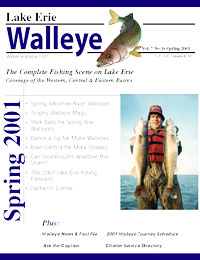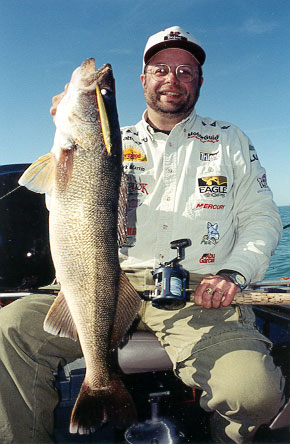Stickbaits for Spring
'Erie Walleyes
by Mark Martin

Order Lake
Erie Walleye Magazine
Three Information-Packed Issues for only $10.00
Delivered to your doorstep every March, June and September
|
Stickbaits for Spring
'Erie Walleyes
|
|
Unlike any waters on earth, Lake Erie is a place where
walleyes suspend and smack stickbaits when the water temperature is 45 degrees.
Come April and May, I know of no better way to target them than with a sizable
suspending jerkbait, say the Rapala Husky Jerk, casting and twitching and
pausing the lure to make it work its magic. Or you can troll the lure to reach
pods of fish chasing bait. But frankly, I know of no method thatís more
exciting  than casting, for time and again heavyweight walleyes will smack the
bait at boatside on a short line of 10 inches or less.
than casting, for time and again heavyweight walleyes will smack the
bait at boatside on a short line of 10 inches or less.
The pitch-and-twitch technique shines wherever you find walleyes but particularly on Erie, where spring fish mow down baitfish around pierheads and river mouths and over reefs in 15 feet of water or less. Whatís more, the system works day or night, slow or fast, in roiled water or clear. You just need to know the little twists that do the job under each condition.
Shiny and Sharp
Indeed, my favorite suspending bait is the Rapala Husky Jerk. The size 10, at 4.5 inches, is the perfect size on Erie when small perch and baitfish measure two to three inches. That slight size difference helps the Husky stand out in a crowd.
So, too, do a few modifications to the color. With poor water clarity or in the dark, I like to trick out my lures with little strips of Witchcraft reflective tape. Try a thin cutout of orange or glow, but donít worry about charging up phosphorescent tape with a flashlight. Itís more trouble than itís worth, and I believe the more subtle coloration is sufficient. You should, however, notice a big difference in the results.
When it comes to color for the bait itself, itís hard to beat gold and black, which works under all water clarities and conditions. Blue and black are my choices for when the waterís calm or clear. When the windís blowing a little harder or the waterís roiled, I switch to firetiger or chartreuse/clown for added visibility. This year Rapala is rolling out three interesting new colors: shad, baby bass and minnow. That said, color is not the be-all and end-all of the Husky Jerk. A complementary quality of the lure is its rattles, which produce a subtle sound similar to a few grains of sand, not an overwhelming maraca clatter that can actually overwhelm the fish.
A couple of other tricks will boost your odds. It helps to take pliers and bend each of the hooks out slightly and sharpen them, the better to sink in when a fish swipes or lightly inhales the bait. I guarantee that the modifications will increase hookups by at least 45 percent. Another helpful hint is to tie your line to a Berkley Cross-Lok snap, which will help you change colors quickly and efficiently, especially in the dark.
Working the Jerk
One of the best things about a Husky Jerk is that even the worst retrieve, reeling it in slow and steady, will still catch fish. But you can do a lot better when you master the twitch and pause.
To do it right, cast out and let the lure settle for a moment, then begin the retrieve for a few cranks of the handle and stop. Next, I slightly pull the rod forward, without reeling, to feel the lure in the water (and to feel a walleyeís surprisingly light strike). From there, I fish the lure back to the boat with jerks about a foot and a half long, with pauses in between. Sometimes Iíll pause the lure as long as 30 or 45 seconds. Just be sure to work the lure all the way back to the boat because walleyes will often hit it when you have hardly any line out.
This is where a reel with a quality drag does wonders. The new Abu-Garcia CD4, a center-drag spinning reel, is smooth and easy to adjust with the new placement of the drag adjustment at the center of the reel, rather than atop the spool. Youíll need to set the drag so it can slip, since a big walleye on a foot or two of line moves too fast for you to be able to backreel. Keep the drag somewhat tight, but not too tight. Make sense?
A rod with a little bit of heft is the ticket, particularly when teamed with Berkley FireLine. A good wand is the medium-heavy six-foot, two-inch Berkley Roach rod in the Signature series. Itís a step up from the lighter jigging rod and offers the backbone to set hooks at a distance. FireLine helps, too. I use very thin six-pound FireLine (it has the same diameter of two-pound monofilament) to get the bait down and set hooks with minimal stretch. A bonus on Erie and the other Great Lakes is that it also helps fend off zebra mussels, which slice monofilament like a knife.
Where and when
The best places to search for walleyes with Raps are along points, dropoffs, inside turns and weedlines. You can even fling them from shore at river mouths and near pilings. Get a Fishing Hot Spots mapóthe company makes an excellent one of Erieís Western Basinóand look for just such spots around the mouth of the Maumee and Sandusky Rivers and around the Bass Islands. You do want to have deep water nearby, say 25 to 30 feet, within a distance of a couple hundred feet. Keeping an eye on the water temperature never hurts either. But unlike on other waters, Erie walleyes will hit stickbaits when the waterís a cool 45, though action does peak in the mid-50-degree range.
Wind and current, as well as the walleyeís surface strafing, are additional clues to their whereabouts. I like to work into the wind or current whenever possible, looking for where walleyes might be positioned. Most often, I find them right on the upstream side of a point or break, holding and feeding where baitfish wash in. But if the wind switches direction after two or three days, I donít give up on where Iíve found fish to go elsewhere. Sure, Iíll give another windy spot a try, but if it doesnít produce, Iíll go back to where I found them before, since it often takes the fish two or three days to set up on a new spot where the wind is blowing. At night, I also listen for the sounds of walleyes brushing the surface. They wonít jump like smallmouths or boil like carp, but theyíll whoosh gently across the surface, a dead giveaway theyíre feeding in the area.
Beyond the twitch-and-pause retrieve, Iíll try two others. If the fish are closer to the surface, Iíll
keep the bait near the surface with a faster retrieve by twitching and stopping, twitching and stopping, without reeling first to get the lure down. If the fish seem to be a little deeper, I crank the bait down and stop, letting it slowly sink downward during those long pauses of up to 30 secnds. This will get the lure down in the zone when the fish are a bit deeper.
For all this talk of casting, trolling is another option to find fish. Often , Iíll pull a Husky Jerk over open water behind planer boards over open water or out in front of river mouths, where baitfish suspend and walleyes are never far behind. Iíll work one deeper, too, with the Down Deep Husky Jerk, which has a larger bill. More often than not, Iíll go back to where Iíve caught a fish and begin casting. There you go, a few more secrets to success for magnum walleyes in close on Erieís inland sea.